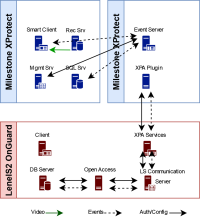Distributed Event Server system design
Video management systems engineered for increased event throughput will commonly include a distributed XProtect Event Server. This is a system design scenario which places the XProtect Event Server in a standalone host server environment, which is specifically outside of the Management Server and/or Recording Server host environments.
Below are the required system design details for integrating and configuring the system to support a distributed Event Server configuration. These include the system design diagrams and data flow, service account requirements, and firewall port requirements.
System architecture diagram for distributed Event Server:
The XProtect Access Plugin for XProtect should be installed on the Event Server. As in all other XProtect Access system design scenarios, the versions of the plugin on the XProtect system and the OnGuard system must match.
Installation and configuration of the Event Server:
All services for XProtect on both the Management Server and Event Server need to be logged on and running as the same account. Testing confirmed that in a domain environment an account with administrative privileges on the XProtect system worked, and the default Network Service account on a Work Group environment worked.
Firewall on the XProtect Event Server and SQL Server
Most of the ports in the list below are opened automatically by the standard XProtect installation programs. To note, firewall TCP port 1433 must be manually opened on the XProtect Event Server host machine. This port facilitates communication between the Event Server and the Microsoft SQL Server.
| XProtect Event Server | |
| Inbound (TCP) | Outbound (TCP) |
|
|
| Microsoft SQL Server | |
| Inbound (TCP) | |
|
|
To learn more about why specific ports need to be opened, and which other ports are required for all XProtect services, read this knowledge base article.


